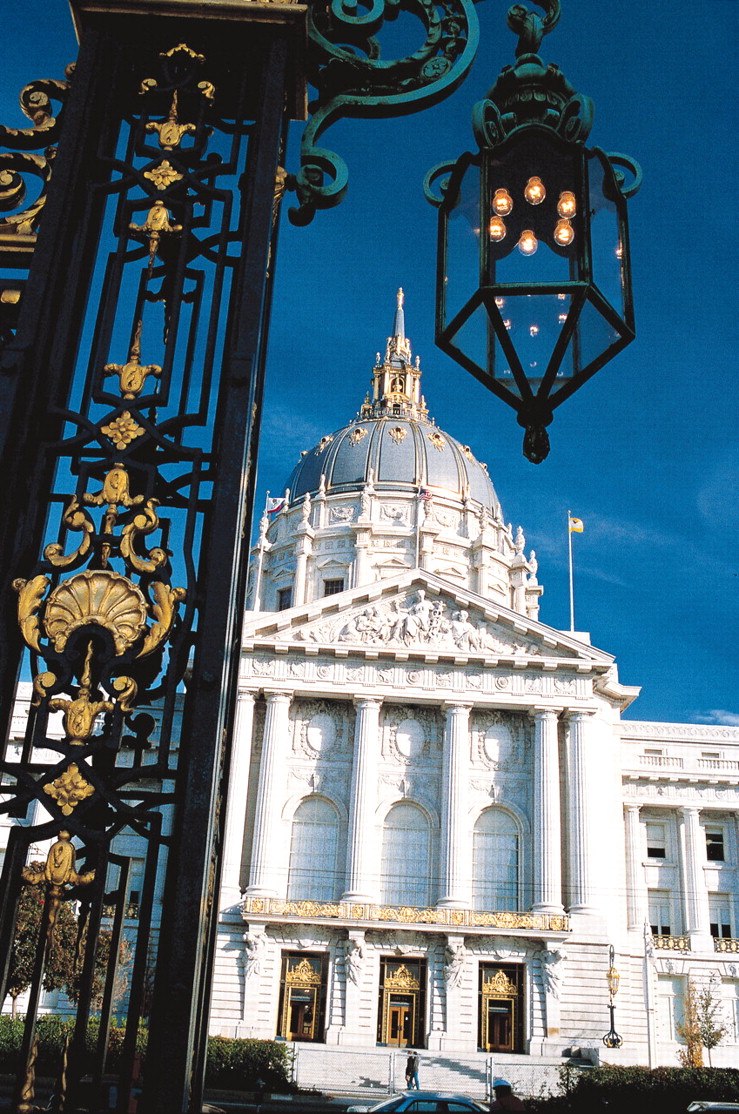San Francisco is certainly no undiscovered gem, as it consistently ranks among the most popular cities for vacations and conventions. So a substantial number of psychiatrists and others attending APA’s 2003 annual meeting have “been there, done that.”
There are a number of less-trodden sites, however, that can provide fascinating diversions for those in search of the new, novel, or simply out of the way in San Francisco.
Surprisingly, one such place is San Francisco City Hall. While most municipal buildings offer little to attract visitors, this one is definitely worth a detour. The most striking feature of this impressive Beaux Arts structure is its copper-covered dome—the fifth-largest dome in world. It boasts a 19-foot advantage over the U.S. Capitol, and the California state capitol also has to look up to San Francisco City Hall.
City Hall is the centerpiece of the Civic Center area, and is one of a collection of imposing Beaux Arts buildings deliberately designed to look like they belonged in turn-of-the-century (the 20th, that is) Paris. The mayor at the time a replacement was being planned for the previous city hall, which was destroyed in the 1906 earthquake, insisted that the architect chosen for the project had to have studied in Paris—believed by many to be the source of all things beautiful and sophisticated. He also made sure the building included a prominent balcony over the large plaza in front of the building so he could address the assembled multitudes.
A popular spot for weddings, more senior readers may recall City Hall’s most famous wedding—that of Marilyn Monroe and Joe DiMaggio in 1954.
In the 1989 earthquake, the dome shifted and cracked. A post-earthquake retrofitting in the early 1990s included the addition of a four-foot moat separating the building from the city’s shaky terrain. It also uncovered skylights that had been covered since the 1940s to make the building less noticeable at night to enemy planes during World War II. Sunlight now drenches the interior.
Across the street from City Hall are two identical (and yes, Beaux Arts) buildings constructed to commemorate the soldiers who fought in World War I. Both buildings, the Veterans Building and the War Memorial Opera House, boast a major historic connection. The meetings and ceremonies that led up to the signing of the United Nations charter were held at the Veterans Building, and the signing itself took place on the stage of the Opera House in 1945. The 1951 treaty that formally closed the curtain on hostilities between the United States and Japan was also signed at the Opera House. The building itself is a jewel and worth a visit by architectural as well as music buffs.
A city as quirky as San Francisco naturally has several unique and offbeat museums. Among those is the Wells Fargo History Museum, which enshrines memorabilia related to the era when thousands of pioneers ventured west from St. Louis in stagecoaches owned by the Wells Fargo company. Since much of the West’s gold was carried on Wells Fargo coaches, the museum has an exhibit of gold taken from each of 60 mines, which displays a surprising range of hues and textures. The hardships of the month’s long journey can be imagined after crowding into one of these stagecoaches on the museum’s top floor.
Speaking of riches, the Museum of Money of the American West displays the variety of currency used during the mid-19th century when the Gold Rush was at its peak. Foreign currency was often used before the U.S. government saw the wisdom of opening a mint in San Francisco in 1854.
Despite its current name, Maiden Lane, near Union Square, was once home to almost every sort of sin San Francisco’s early settlers could imagine. Then known as Morton Street, the center of the infamous area known as the Barbary Coast once imported prostitutes by the hundreds from the rest of the United States, Asia, and Mexico. You’ll have to use your imagination, though, since it’s now lined with pricey shops.
Architecture buffs take note: One current denizen of Maiden Lane is Folk Art International, a shop whose chief claim to fame is that it is San Francisco’s only nonresidential Frank Lloyd Wright–designed building.
Speaking of striking architecture, the city’s famous Castro neighborhood, symbolic home to gays and lesbians throughout the country—and actual home to thousands—boasts the last surviving example of the Art Deco movie theaters that once dotted the city. The Castro Theatre resembles a Moorish castle with tile and other ornate decorations characteristic of the art and architecture of the 1920s and 1930s. Prior to many of the films, a classic Wurlitzer organ appears below the screen, and the theater’s organist serenades movie goers.
One particularly child-friendly spot well off the beaten path for tourists is the Randall Museum, which sits on a hill above the Mission and Castro districts off Market Street. In addition to its mission to educate about the environment and culture of the Bay Area, it is home to about 100 animals that have been rescued because they were not likely to survive in the wild with injuries or other factors. While glass partitions separate some exhibits from curious humans, most of the birds and other animals move about unfettered by cages or enclosures found in most zoos. And a surprise for kids and their parents awaits them in the building’s basement. That is where the Golden Gate Model Railroad Club makes its home, and from 11 a.m. to 4 p.m. on Saturdays train enthusiasts turn on the extensive mockups they’ve created.
Oh, and of course any first-time of veteran visitor sensitive to local customs knows never to call the city Frisco! ▪

